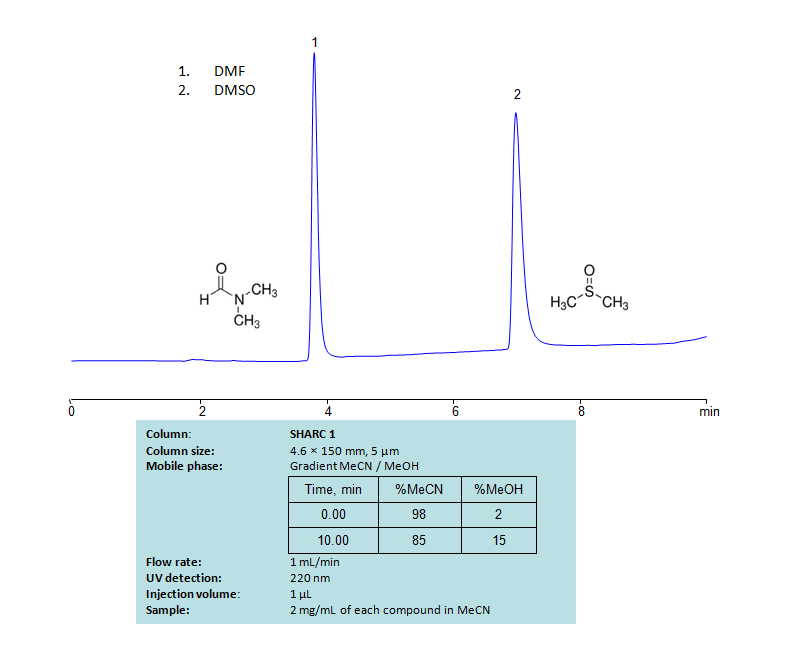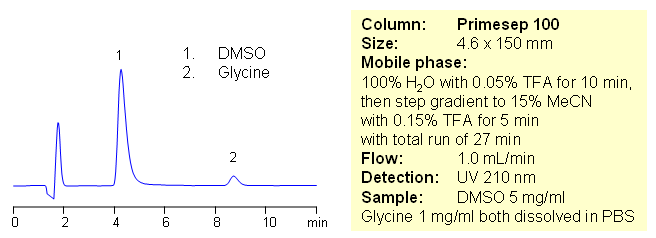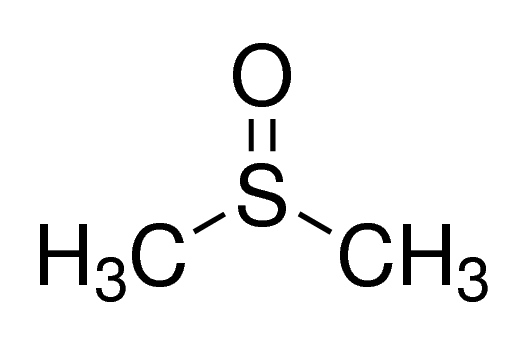| CAS Number | 67-68-5 |
|---|---|
| Molecular Formula | C2H6OS or (CH3)2SO |
| Molecular Weight | 78.129 |
| InChI Key | IAZDPXIOMUYVGZ-UHFFFAOYSA-N |
| LogP | -0.6 |
| Synonyms |
|
Applications:
HPLC Separation of Mixture of DMF and DMSO
April 25, 2019

Dimethylformamide, DMF, is primarily used as an organic solvent and is miscible with water and most other organic liquids. Dimethyl sulfoxide (DMSO) is also a solvent. It can dissolve both polar and nonpolar compounds and is miscible with water and other organic liquids. Both compounds can be retained and separated using anhydrous (water-free) conditions using HPLC by SHARC 1 column, which uses hydrogen-bonding as a separation mechanism. The method uses a gradient of acetonitrile (ACN) and methanol (MeOH) mobile phase without the need for a buffer. UV detection used at 220nm.
| Column | Sharc 1, 4.6×150 mm, 5 µm, 100A |
| Mobile Phase | Gradient MeCN – 98-85 %, 10 min |
| Buffer | No |
| Flow Rate | 1.0 ml/min |
| Detection | UV, 220 nm |
| Class of Compounds |
Drug, Basic, Hydrophobic, Ionizable, Zwitterionic |
| Analyzing Compounds | DMF, DMSO |
Application Column
SHARC 1
The SHARC™ family of innovative columns represents the first commercially available columns primarily utilizing separation based on hydrogen bonding. SHARC stands for Specific Hydrogen-bond Adsorption Resolution Column. Hydrogen bonding involves an interaction or attraction between a bound hydrogen atom and molecules containing electronegative atoms, such as oxygen, nitrogen, and fluorine.
Select optionsDMSO (Dimethyl sulfoxide)

HPLC Separation of DMSO and Glycine by Mixed-Mode Chromatography
July 16, 2009

Dimethyl sulfoxide is important polar aprotic solvent, which is frequently used in pharmaceutical drug manufacturing, desolution, etc. DMSO is used as one of the solvents on protein chemistry due to universal ability to dissolve small molecules like amino acids. Amino acids and DMSO are very polar and have no retention on reversed-phase columns. In this HPLC application DMSO and glycine are separated on Primesep 100 mixed-mode column. DMSO is retained by weak reversed-phase mechanism and very low organic concentration is required in order to achieve any retention. Glycine, like any other underivatized amino acid, is retained by weak reversed-phase and moderate cation-exchange mechanism. Method uses acetonitrile/water/TFA gradient and UV detection.
| Column | Primesep 100, 4.6×150 mm, 5 µm, 100A |
| Mobile Phase | MeCN/H2O |
| Buffer | TFA |
| Flow Rate | 1.0 ml/min |
| Detection | UV, 210 nm |
| Class of Compounds |
Drug, Acid, Hydrophilic, Ionizable, Vitamin, Supplements, Amino acid |
| Analyzing Compounds | DMSO, Glycine |
Application Column
Primesep 100
The Primesep family of mixed-mode columns offers a wide variety of stationary phases, boasting unprecedented selectivity in the separation of a broad array of chemical compounds across multiple applications. Corresponding Primesep guard columns, available with all stationary phases, do not require holders. SIELC provides a method development service available to all customers. Inquire about our specially-tailored custom LC-phases for specific separations.
Select optionsDMSO (Dimethyl sulfoxide)
Glycine




